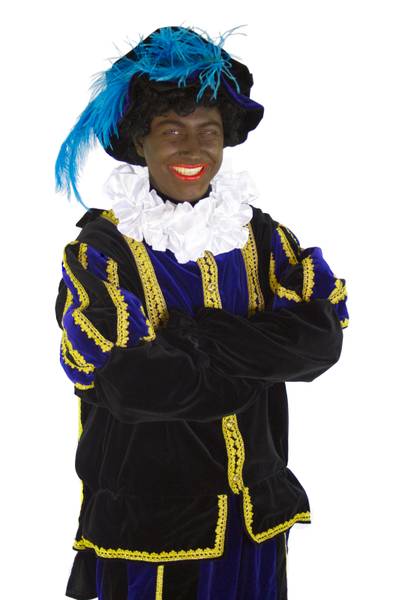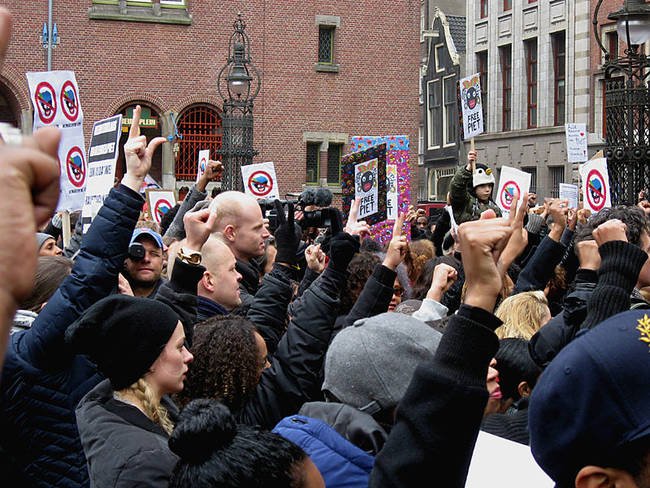In the Dutch tradition, the figure of St. Nicholas, known as Sinterklaas, distributes toys to good children on St. Nicolas Day, which falls on December 5. The celebration of this figure in the U.S. dates back many hundreds of years, and is the basis for the American Santa Claus. In the late 1700s, Dutch colonists in New York City (originally New Amsterdam) celebrated this, and it carried over into American folklore, where it continues today. Some places, particularly those with a Dutch heritage in New York State, still celebrate St. Nicholas Day in early December.
There is, though, a Dutch tradition that was thankfully not carried across the Atlantic, and that is Zwarte Piet, or, in English, Black Peter. Zwarte Piet is depicted as a black man, and usually played, in pageants and parades, by a white actor in blackface. Needless to say, this has caused some controversy in recent years–and probably rightfully so.
Zwarte Piet’s origins remain slightly unclear to this day. Some people claim he’s a human version of the Norse god Wodan’s ravens, literally black in color, who would listen at the chimneys of humans to make sure they were behaving, which is an activity Zwarte Piet is known for. Other people draw a parallel between him and Krampus, the demon-like figure that would punish naughty children. In some images, St. Nicholas is holding Krampus on a chain or tether, and at some point in the 19th century, this figure was transformed into a Moor. The idea of a person of African descent being held as a captive is pretty shocking to a modern audience because of its obvious allusion to slavery.
Still another theory simply has the character begin as an image of one of St. Nicholas’ servants; images of white people with black servants was actually quite common in Europe and America, where the black people would be used to show the status of the white person–essentially, as objects–so the character may have stemmed from a similar image.
It’s important to note that while something like this seems blatantly racist to us, people living hundreds of years ago would probably have never thought of it that way, and didn’t understand the racist implications of the character. It was still racist, but the societies didn’t–or wouldn’t–understand that. Beginning in the early 20th century, and continued today, Zwarte Piet is known as a friend of children, carrying a bag of sweets. Despite his status as a servant, he’s generally considered an equal to St. Nicholas, and partakes in both distributing treats and meting out punishment.
In what might have been an attempt to smooth over the racist implications of Zwarte Piet, several new origin stories were proposed for him in the 20th century. In one, he’s freed from slavery in Babylon by St. Nicholas (and his skin color is notably, perhaps conspicuously, absent from the story) and the two become eternal friends. In another, his blackness is described not as his actual skin color, but from his job as a chimney sweep, which leaves him perpetually covered in black soot.
Both stories are attempts at making the character less racist, but in recent years, the controversy has gained traction. Another tactic was to have St. Nicholas accompanied by not one but many Piets, including female Piets, of all colors (literally), each with a particular job. Still, some are not pleased about the character at all, and see him as an embarrassing and offensive holdover from a less understanding time. Dutch comedian Erik van Muiswinkel, who played a “Head Piet” in a TV special, urged revisions of the character in 2013. Others, including American essayist David Sedaris and British comedian Russell Brand, have spoken out against the tradition. Demonstrations against the character, as well as counter-demonstrations, have been held, some resulting in physical altercations.
Still, the vast majority of Dutch people–92%–don’t see Zwarte Piet as racist, or linked to slavery, and cultural and anti-oppression coalitions in both the Netherlands and Belgium opted to preserve the character but promote changes, rather than remove him entirely. However, they urged event organizers and the like to refrain from giving Piet anything less than the honor and dignity that they gave St. Nicholas. They recognize, though, that it will be a challenge to change a deeply-entrenched figure and to help people learn to be a little more understanding of the hurt that a character like Zwarte Piet might cause black communities in the Netherlands and in former Dutch colonies like Suriname.
So what will happen to Zwarte Piet? It may be too early to tell. Giving up a tradition that holds good memories, just like admitting that you might be partaking in a racist act, is very hard to do on both an individual and a societal level. Attempts are being made to reinvent the character into something more appealing to everyone, but his origins will always come with the baggage of racism. The tragedy of racism continues today, but maybe with awareness and understanding, we can make things better.
 share
share
 share
share
 share
share



